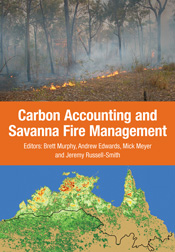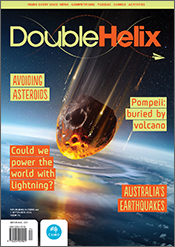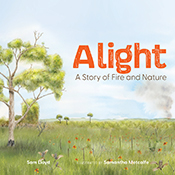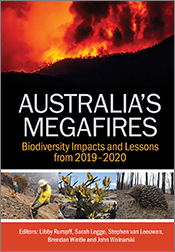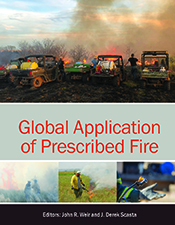Carbon Accounting and Savanna Fire Management
Edited by: Brett P Murphy, Andrew C Edwards, CP (Mick) Meyer, Jeremy Russell-Smith
Explores methodologies for accounting for greenhouse gas emissions abatement from savanna fire management.
In the context of Australia’s developing carbon economy, fire management helps to abate emissions of greenhouse gases and is an important means of generating carbon credits. The vast high-rainfall savannas of northern Australia are one of the world’s most flammable landscapes. Management of fires in this region has the potential to assist with meeting emissions reduction targets, as well as conserving biodiversity and providing employment for Indigenous people in remote parts of Australia’s north. + Full description
This comprehensive volume brings together recent research from northern Australian savannas to provide an internationally relevant case study for applying greenhouse gas accounting methodologies to the practice of fire management. It provides scientific arguments for enlarging the area of fire-prone land managed for emissions abatement. The book also charts the progress towards development of a savanna fire bio-sequestration methodology. The future of integrated approaches to emissions abatement and bio-sequestration is also discussed.
- Short descriptionNews
This title is no longer available in print, but can still be purchased as an eBook.
Reviews
"The book, though having an unashamedly Australian focus, provides information potentially useful to a wide range of African scientists. It has extensive coverage of remote sensing-based methodologies for different applications in fire, vegetation and emission mapping. Furthermore, it has a number of chapters aimed at vegetation ecologists attempting to understand vegetation–fire interactions. It also provides extensive guidelines on understanding and measuring emissions from fires and valuable insight into how such multidisciplinary data can be integrated to develop an emission reduction methodology."
Graham von Maltitz, African Journal of Range and Forage Science, 33(3), 2016, pp. 215-216
"An excellent resource for hands-on managers who want to know how to benefit from carbon emission abatement programs planned for the future carbon economy, as well as academics and students interested in fire ecology. Carbon Accounting and Savanna Fire Management compiles outcomes of the most recent research on carbon methodologies that form essential reference for future greenhouse gas abatement programs in Australia as well as across the world."
Pawel Waryszak, Pacific Conservation Biology 24(1), 2017
Details
ePDF | June 2015ISBN: 9780643108523
Publisher: CSIRO Publishing
Available from eRetailers
ePUB | June 2015
ISBN: 9780643108530
Publisher: CSIRO Publishing
Available from eRetailers
Features
- Comprehensive treatment of lower rainfall savanna burning greenhouse gas emissions abatement methodology.
- Charts the progress made towards the development of an associated savanna burning bio-sequestration methodology.
- Discusses the future improvements in integrated approaches to emissions abatement and bio-sequestration.
- A technical work that is internationally relevant and highly topical.
Contents
Preface and acknowledgementsList of contributors
Chapter 1
Reimagining fire management in fire-prone northern Australia
Chapter 2
Fire patterns in north Australian savannas: extending the reach of incentives for savanna fire emissions abatement
Chapter 3
Fire extent mapping - procedures, validation and website application
Chapter 4
Vegetation Fuel type classification for lower rainfall savanna burning abatement projects
Chapter 5
The operational role of satellite-based fire data in Savanna Burning Methodologies
Chapter 6
Fuel Accumulation, consumption and fire patchiness in the lower rainfall savanna region
Chapter 7
Leaf and Coarse Fuel Accumulation and Relationships with Vegetation Attributes in 'Evergreen' Tropical Eucalypt Savannas
Chapter 8
Measuring and Mapping Fire Severity in the Tropical Savannas
Chapter 9
Biomass combustion and emission processes in the Northern Australian Savannas
Chapter 10
Application of a ‘lower rainfall’ savanna burning emissions abatement methodology
Chapter 11
Reconciling ‘bottom-up’ and ‘top-down’ greenhouse gas accounting methodologies for savanna burning in Northern Australia
Chapter 12
Fire or water – which limits tree biomass in Australian savannas?
Chapter 13
Predicting the effects of fire management on carbon stock dynamics using statistical and process-based modelling
Chapter 14
Towards a methodology for increased carbon sequestration in dead fuels through implementation of less severe fire regimes in savannas
Chapter 15
Where to from here?
Index
View the full table of contents (PDF).
Authors
Brett P. Murphy is a tropical fire ecologist at the University of Melbourne, whose work focuses on the broad question of how to optimally manage landscape fire for the conservation of biodiversity, especially in the vast savanna landscapes of northern Australia. His current research examines the role of altered fire regimes in the ongoing decline of northern Australian mammals, and the role of fire in controlling the structure and function of northern Australian savanna vegetation.Andrew C. Edwards is a fire ecologist and remote-sensing specialist at the Darwin Centre for Bushfire Research at Charles Darwin University. He played a central role in developing the extensive spatial datasets for the groundbreaking West Arnhem Land Fire Abatement project. This work underpinned the development of the first Savanna Burning methodology for greenhouse gas emissions abatement. He was also part of the team that undertook extensive survey work to describe the seasonality of patchiness and fire severity, and the accumulation of bio-fuels for that methodology. Andrew has since developed satellite-derived fire severity mapping.
Mick Meyer is an atmospheric scientist at the CSIRO with 35 years’ experience measuring emissions and uptake of pollutants and greenhouse gases and developing methods for their accounting. Mick is the author of the current national accounting methodologies for greenhouse gas emissions from bushfires, and is an active contributor to UN and IPCC accounting methodologies for combustion processes.
Jeremy Russell-Smith is a consultant ecologist with 25 years’ experience in northern Australia. He coordinates fire research programs for the Darwin Centre for Bushfire Research and works on other natural resource management projects in South-East Asia. He has an abiding interest in the ecology, biogeography and management of monsoon rainforests and sandstone heaths. He often works with Indigenous people on landscape and resource management issues.
Contributors: Shaun Ansell, Mila Bristow, Peter Brocklehurst, Susan Campbell, Garry D Cook, Martin Cope, Aaron Crosbie, Nicholas Cuff, Mark Desailly, Jay Evans, Rohan Fisher, Jarrad Holmes, Lindsay B Hutley, Peter Jacklyn, Glenn James, Aidan Joseph, Sunhee Lee, Sarah Legge, Ben Lewis, Fay Lewis, Adam C Liedloff, Ashok Luhar, Dominique Lynch, Stefan W Maier, Ross Mitchell, Catherine Monagle, Sofia Oliveira, Anna Pickworth, Tom Vigilante, Jake Weigl, Peter J Whitehead, Cameron P Yates, Stuart Young.

